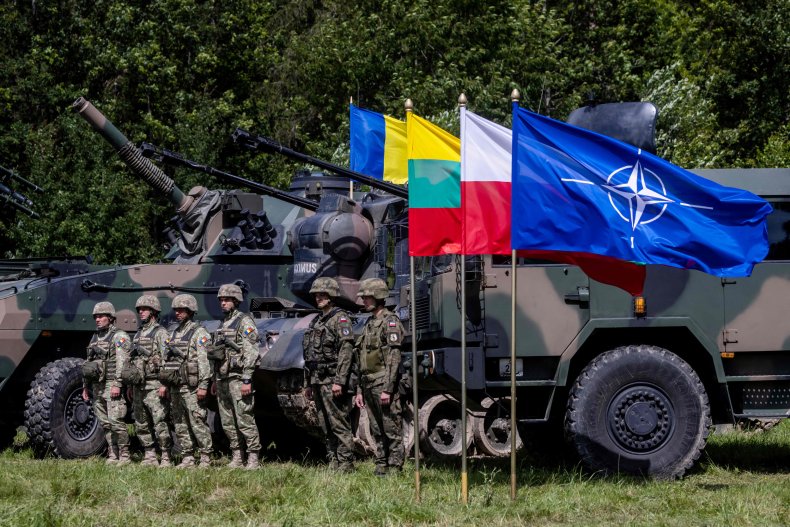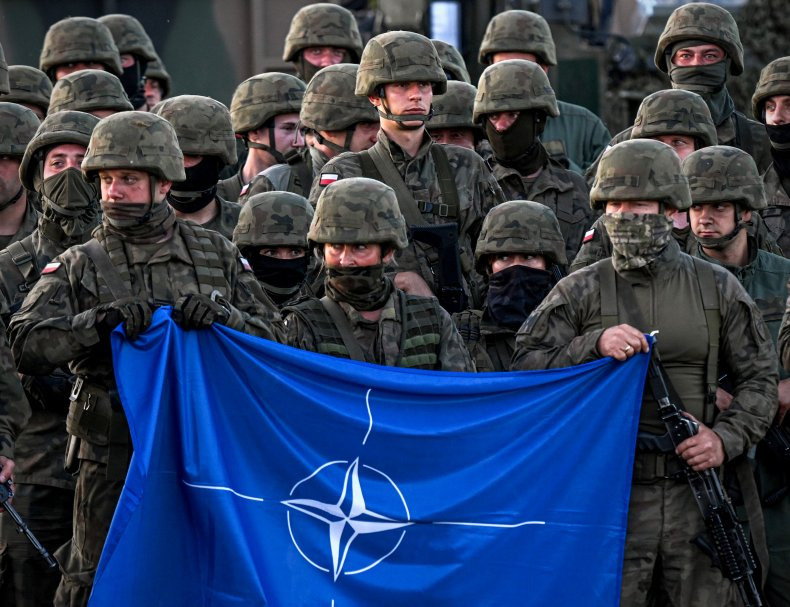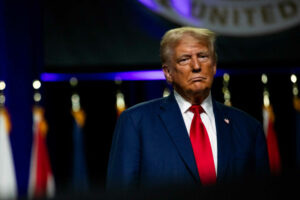Vladimir Putin’s full-scale invasion of Ukraine has spurred NATO members to plan in detail what has been unthinkable since the end of the Cold War—a direct conflict with Russia.
However, ahead of the bloc’s summit in Vilnius, Lithuania, starting on July 11 when countering Russia will be top of the agenda, Sir Richard Shirreff, the former Deputy Supreme Allied Commander Europe, said NATO was not ready for a war with Moscow.
“It needs a real kick up the backside,” he told Newsweek, as he took aim at dwindling military budgets across alliance members, although there are exceptions, such as Poland.
“There is a massive war going on in Eastern Europe. It’s a land war and it’s an air war, and so you need to invest in air and land, and that hasn’t been done,” Shirreff said. “Last year at its Madrid summit, (Alliance Secretary General) Jens Stoltenberg announced that NATO would ramp up its very high readiness forces to 300,000—that simply hasn’t happened.”
The former British general said that the U.K. Army was an example of such cuts across the bloc being run down to a “ludicrous size” as he believed that the defense establishment had believed that China, not Russia, was the major long-term threat.
“Geography matters here and Russia is the wolf nearest the sledge,” said Shirreff, the managing partner at the consultancy Strategia Worldwide. He believed there has been a “failure of deterrence” by the alliance, which missed an opportunity to build up capability after Putin seized Crimea in 2014.
“Am I confident that NATO will really be able to generate conventional forces ready for a conventional war with Russia? No, I’m not.”
Classified Documents
Even if the Kremlin and Russian state media say that the war is already a proxy one between Moscow and NATO, the alliance has taken pains to avoid a direct role in the fighting, instead providing Ukraine with equipment to take on Moscow’s aggression.
But one of NATO’s top officials, Admiral Rob Bauer, said in May that the alliance had to prepare for the fact “that conflict can present itself at any time,” directly with Moscow, Reuters reported.
This is why NATO will examine thousands of pages of classified documents outlining regional plans and guidance on how members can upgrade their forces and logistics in the most detailed plans since the end of the Cold War.
The plans also entail assigning troops to defend different regions and gives details on “where, what and how to deploy,” Stoltenberg said last month, according to Reuters. This will build on the process spurred by the annexation of Crimea after which Western allies deployed combat troops to eastern Europe.
What will be discussed at the summit “looks like due diligence to back up what NATO has been preparing and doing anyway,” Rose Gottemoeller, the former deputy secretary general of the alliance told Newsweek.
NATO Battle Groups
In March, Stoltenberg announced the alliance would deploy four new battle groups, each with around 1,500 troops, across Bulgaria, Hungary, Romania and Slovakia.
Stoltenberg said the aim would be to “strengthen NATO’s posture in all domains with major increases of forces in the eastern part of the alliance, on land, in the air, and at sea.” NATO already has battlegroups in Estonia, Latvia, Lithuania and Poland.
“They are the front line and if the Russians should attack, they would take the first blows,” said Gottemoeller. “It leaves Russia in no doubt that if it attacks the NATO alliance in one place, for example in the Baltic States, it will be attacking all of NATO and all of NATO will come to an immediate response.”
She said the planning for a war between NATO with Moscow is part of an almost decade-long effort to return the alliance to a firmer defense posture than it had since the end of the Cold War and the September 11 attacks, after which it focused on counterterrorism.
“NATO has known, since the invasion of Crimea in 2014 and the way Russia has been more obstreperous in general on NATO’s borders, that NATO may need to be ready to fight and defend itself very rapidly against a Russian attack,” said Gottemoeller.

Article Five
Concerned enough about Europe’s biggest war since 1945, western capitals were briefly rattled by the appearance of a Russian missile in NATO member Poland in November 2022, and the ramifications for Article Five, the collective defense pledge of the alliance’s charter.
An assessment that it likely came from Ukraine trying to intercept a Moscow missile cooled temperatures, although a paper from the non-profit thinktank Rand Corporation a month later said NATO’s support for Kyiv “raised concerns about possible Russian retaliation against the alliance.”
The paper notes that United States and NATO planners have long focused on preparing for an outright conflict with Russia but the war in Ukraine “has created a unique set of circumstances that make a more limited Russian attack plausible.”
With its paper, Rand outlined various scenarios involving a Russian attack on a NATO target, how the alliance would react and what Moscow’s next move would be.
A “demonstrative” attack could be, for example, on an airfield with few casualties. A “focused” strike would be more impactful and could affect NATO operations.
Then “less restrained” strikes on military and civilian targets might produce substantial casualties, potentially to both civilian and military personnel. It concludes that higher-intensity Russian attacks leave the U.S. with fewer options that achieve its goals.
Any NATO response to an attack on Moscow “depends on what you think of the attack represents,” report co-author and senior political scientist at Rand, Karl P. Mueller told Newsweek.
“If it’s the Russians panicking and feeling desperate, you treat it differently than if you think they’re doing it for right instrumental military reasons because they think this is this is a good way to win the war,” he said.
The summit in Vilnius shows that NATO is embarking on a new phase of its defense strategy, with Finland having joined, and Sweden’s membership stalled.
“There’s going to be a lot of discussion about what commitments individual nations are going to make, who’s going to contribute forces to what, and probably a lot of efforts to coordinate those,” Mueller said.
“Being prepared is in some ways easier now than it was a year and a half ago because a lot of Russian military capabilities have been degraded by the war,” he said. “NATO has a window of opportunity when it can make major changes to the alliance’s defense strategy and organization.”
Source : NewsWeek









